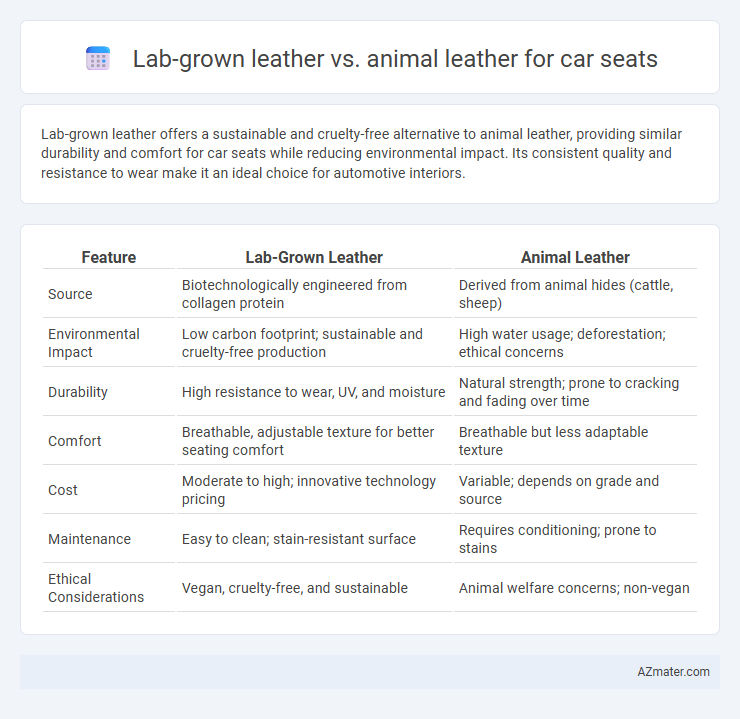Lab-grown leather offers a sustainable and cruelty-free alternative to animal leather, providing similar durability and comfort for car seats while reducing environmental impact. Its consistent quality and resistance to wear make it an ideal choice for automotive interiors.
Table of Comparison
| Feature | Lab-Grown Leather | Animal Leather |
|---|---|---|
| Source | Biotechnologically engineered from collagen protein | Derived from animal hides (cattle, sheep) |
| Environmental Impact | Low carbon footprint; sustainable and cruelty-free production | High water usage; deforestation; ethical concerns |
| Durability | High resistance to wear, UV, and moisture | Natural strength; prone to cracking and fading over time |
| Comfort | Breathable, adjustable texture for better seating comfort | Breathable but less adaptable texture |
| Cost | Moderate to high; innovative technology pricing | Variable; depends on grade and source |
| Maintenance | Easy to clean; stain-resistant surface | Requires conditioning; prone to stains |
| Ethical Considerations | Vegan, cruelty-free, and sustainable | Animal welfare concerns; non-vegan |
Introduction: The Rising Debate Over Car Seat Leathers
Lab-grown leather for car seats offers a sustainable alternative to traditional animal leather by reducing environmental impact and animal cruelty concerns. Innovations in biofabrication have enabled lab-grown leather to match or surpass the durability and aesthetics of conventional leather used in automotive interiors. The growing consumer demand for eco-friendly materials is driving automakers to explore lab-grown leather as a viable option for luxury and mass-market vehicles.
What Is Lab-Grown Leather?
Lab-grown leather, also known as cultured or biofabricated leather, is produced by cultivating animal cells in a controlled environment to create leather material without the need for traditional livestock farming. This innovative process results in a sustainable and eco-friendly alternative that exhibits comparable durability, texture, and appearance to conventional animal leather. Car seat manufacturers increasingly adopt lab-grown leather to reduce environmental impact and meet consumer demand for ethical materials without sacrificing quality or comfort.
Animal Leather: Traditional Appeal and Performance
Animal leather remains a preferred choice for car seats due to its natural durability, breathability, and luxurious texture, offering superior comfort and aging qualities that enhance with use. Its ability to develop a unique patina over time provides a classic aesthetic appeal highly valued in premium automotive interiors. Despite concerns about sustainability, animal leather's proven performance in wear resistance and temperature regulation continues to set industry standards for quality car seat materials.
Manufacturing Process: Lab-Grown vs Animal Leather
Lab-grown leather is produced using cultured cells in a controlled environment, minimizing the need for animal farming and significantly reducing resource consumption and waste emissions. Animal leather manufacturing involves animal rearing, slaughtering, and extensive tanning processes using chemicals like chromium, which contribute to environmental pollution. The lab-grown process offers scalability with fewer ecological impacts, whereas traditional leather depends heavily on livestock agriculture and chemical-intensive treatments.
Durability and Longevity Comparison
Lab-grown leather offers enhanced resistance to wear and tear due to its controlled manufacturing process, ensuring consistent quality and fewer imperfections than traditional animal leather. Animal leather, while naturally strong and breathable, tends to develop cracks and fade over time, especially under high exposure to sunlight and humidity typical in car interiors. Advances in lab-grown leather technology have improved its durability and UV resistance, making it a viable and longer-lasting alternative for car seat upholstery.
Comfort and Aesthetics: Texture, Feel, and Customization
Lab-grown leather offers enhanced customization options for car seats, allowing precise control over texture and color, creating a consistent, premium appearance. Its smooth, supple feel closely mimics traditional animal leather, providing comparable comfort while being more breathable and resistant to wear. Animal leather maintains a natural grain and patina unique to each hide, delivering a luxurious tactile experience but with less variability in design flexibility.
Environmental Impact: Sustainability and Carbon Footprint
Lab-grown leather for car seats significantly reduces environmental impact by utilizing less water, energy, and land compared to traditional animal leather, which requires extensive livestock farming contributing to deforestation and methane emissions. The carbon footprint of lab-grown leather is substantially lower, as it eliminates the need for raising cattle and minimizes greenhouse gas emissions associated with animal agriculture. Sustainable production methods in lab-grown leather support circular economy principles, offering a scalable alternative that mitigates the ecological damage linked to conventional leather manufacturing.
Ethical Considerations: Animal Welfare and Alternatives
Lab-grown leather offers a sustainable and cruelty-free alternative to traditional animal leather, significantly reducing the environmental impact and ethical concerns associated with animal farming and slaughter. This innovative material eliminates the need for animal hides, addressing animal welfare issues while providing comparable durability and aesthetic quality for car seats. Adoption of lab-grown leather in the automotive industry supports ethical manufacturing practices and aligns with growing consumer demand for cruelty-free and eco-friendly vehicle interiors.
Cost Analysis: Affordability and Market Trends
Lab-grown leather for car seats offers a potential reduction in production costs due to scalable biofabrication techniques, making it increasingly competitive against traditional animal leather, which involves higher expenses related to livestock rearing, tanning, and environmental regulations. Market trends indicate a growing demand for sustainable and ethically produced materials, driving investments and technological advancements that are expected to decrease lab-grown leather prices by 15-20% over the next five years. Affordability remains a key factor as consumers and automakers prioritize cost-effective, environmentally friendly alternatives, with lab-grown leather projected to capture an increasing market share in the automotive upholstery sector.
Future Outlook: The Road Ahead for Car Seat Materials
Lab-grown leather offers a sustainable alternative to traditional animal leather for car seats, significantly reducing environmental impact through lower greenhouse gas emissions and water usage. Innovations in biotechnology and material science are driving improvements in durability, texture, and cost-efficiency, making lab-grown leather increasingly viable for automotive applications. The future of car seat materials is poised for a shift towards eco-friendly, ethically produced options, with lab-grown leather positioned as a key player in advancing sustainable mobility solutions.

Infographic: Lab-grown leather vs Animal leather for Car seat
 azmater.com
azmater.com